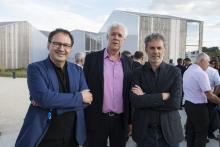
Agence Ter is an independent firm of landscape architects, landscape engineers & urban designers, with the head office based in Paris. Furthermore, Agence Ter has branch offices in Karlsruhe (Germany), Barcelona (Spain), Shanghai (China) and Los Angeles (USA).
Agence Ter is currently involved in a wide range of projects across the world: Territorial studies such as Nantes/Saint-Nazaire coastal area, Rennes Vilaine Valley area, Antwerp ring area, the grünmetropol transnational area; master planning as well as urban design in France, Switzerland, China, Germany, Morocco, Belgium; public space projects for example the “Canopia Urbana” project in Barcelona, "Pershing Square" in Los Angeles and the "Huangpu East Bank" in Shanghai.
Conceptualizing the essence of a project whilst using physical, geographical or historical and memory-based elements as a foundation allows for a wider understanding of the challenges, a fostering of the dialogue between the stakeholders and a facilitation of interactive exchanges with the residents. Far from opposing contextual and conceptual approaches, Agence Ter aims on the contrary to achieve a judicious balance of the two, ultimately operating at different scales, from the district to the inter-urban area, and all the way up to the large-scale territory.
The contemporary city is constantly changing and the urban, peri-urban and suburban aspects must be considered more often than not with a greater landscape presence. The goal is therefore to successfully combine landscape and urban aspects through constant research. It is only by starting from the landscape, and the understanding of this, that we can develop new urban forms: the range for experimentation is now very broad, fostered by the widely shared desire and obligation to address at a very early stage of the project the questions regarding the environment, surface water management, energy efficiency, climatic change, the optimisation of public space maintenance, the integration of new materials and technologies. This goes well beyond the issue of sustainable constructions as it is the notion of a sustainable territory that must be considered within the context of a project approach, for example to demonstrate that the creation of a new urban structure can strengthen a site’s biodiversity as well as lowering the heat island effects and ensuring food supply at a metropolitan scale.








